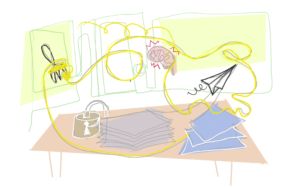Design thinking is human-centered. And there is nothing more valuable, precious, or intimate to humans than their well-being and quality of life. That’s that short straight-forward version of the answer. If you have few minutes to spare, read on!
We all know how healthcare has nowadays become more about medical science and efficiency in delivery, both of which resulted in a de-humanized care to some degree. Care has become more mechanical in nature and lost the healing touch of the medical profession. There is a plethora of initiatives and campaigns around the world to bring more humanity back to healthcare. That’s why injecting human-centered approaches like design thinking based on empathy and understanding is a necessity to put back patients and their families in the center of attention.
Patient-centered care:
Person-centered care has become a cornerstone in any effort to improve quality and outcomes of care. Engaging patients in the decision making process, empowering them to take charge of their own health, and enhancing their experiences within the care system are all essential requirements for person centered care. To achieve that, however, many healthcare organizations and providers lack the skill and tools that would help them understand and meet patients’ needs, wants, and ambitions. This is where design thinking shines with many of its tools embedded in anthropology and social science design such as insight gathering , empathy mapping, and patient experience journey mapping to name a few. I believe that organizations should strive to develop the knowledge and skills to arrive at a truly patient centered design of its systems, processes, and services. By doing that, hospitals and healthcare systems at large will grow their arsenal of tools and techniques for quality improvement of care delivery and outcomes.
The science of improvement:
There were a lot of advances in the way healthcare quality improvement is implemented, with the wide adoption of models based on the scientific method of experimentation and studying. The famous PDSA cycles used as an improvement methodology or as iterations of testing changes resembles the prototyping and testing stages of design thinking. In many instances however, improvements are provider-centric and are planned and implemented using rigid approaches that are based on what professionals think are the best for the patients or the systems, in the name of science. Involvement of patients and other end users if you like are often superficial and seems rushed. As a creative problem-solving approach, design thinking brings many important elements which are usually overlooked or less emphasized to say the least. It calls for more time and attention to framing and reframing problems which will eventually paves the way for ideation to come up with creative and effective solutions for better and long-term impact. On top of all that, design thinking focuses at its core on empathy and collaborative design with patients and frontline providers alike. Those are the people who could truly define what value is and what matters to them most.
Value-based healthcare:
Due to financial challenges and the unsustainable delivery of care that traditional health systems are built around, many systems are attempting huge transformations to what is usually referred to as value-based healthcare (VBHC). Concepts and principles of VBHC are evolving and ranges from individual experience of care to population health.
While the “what” is fairly known and have been studied with many successful examples, the “how” is relatively less defined with many transforming systems struggling to identify the starting point and how to go about applying the necessary change. As Richard Buchanan wrote about Wicked Problems in Design Thinking , I can’t think of a field as complex with many wicked problems and increasing uncertainty as healthcare. Current and future transformation in healthcare requires new solutions to address inefficiencies, quality and safety challenges, and inequities. Also, innovation is growingly called for in healthcare to ensure proper implementation of clinical guidelines, pathways, and interventions. Design thinking is well suited to help tackle many of the above to a great deal.
In her article “Why Healthcare Needs Designers”, Tina Park brilliantly highlights the skillset designers could bring to the table to deal with the complexity of healthcare. To build on that, I suggest not only brining designers in the picture, but to infuse healthcare system strategies with the design thinking mindset, and equally important, to develop the capacity among the healthcare professionals and other stakeholders to work together with patients and community at large to find better ways to design and redesign a more human, innovative, and sustainable care experience.




